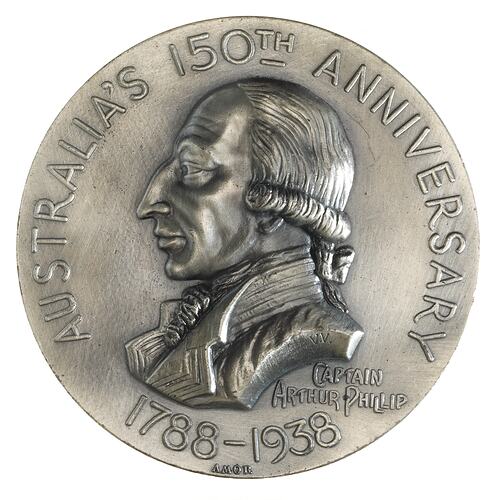Arthur Phillip was born in London on 11 October 1738, and at the age of 12 was enrolled at a school for the sons of seamen in Grenwich. He completed four years of apprenticeship in the merchantile service, including two years at sea. He then transferred to the navy and saw active service during the Seven Years' War. In 1761, at the age of 22, he was appointed lieutenant on a provisional basis, and was confirmed in this position the following year when he was involved in the capture of Havana. When peace was declared he retired on half pay, and his connections with the navy over the following 15 years were largely nominal. He acquired properties and settled with his new wife Margaret, but the marriage was unhappy and they separated after six years. In 1774-78 Phillip served as a captain in the Portuguese fleet, with the Admiralty's permission, then in 1778 returned to the British navy. In 1781 he became post captain, and was given command of the gunship Ariadne; the following year he moved to command the Europe. He was again retired on half pay in 1784, after seeing no action in his gunships.
Following a year in southern France, 48-year-old Phillip was appointed first governor of New South Wales in 1786, in an area embracing roughly half of eastern Australia and Norfolk Island. Phillip was inspired by the possibilites of the colony, but did not want to see convicts 'lay the foundation of an Empire'. He showed himself a capable and insightful administrator as he laid plans for the colony.
The First Fleet left England on 13 May 1787 and arrived in Botany Bay on 18 January 1788. The success of the voyage owed much to Phillip. On landing, Phillip identified Port Jackson as a more suitable place for a settlement, and on 26 January 1788 landing operations began there.
Phillip enjoyed absolute powers in the colony, only accountable to the Colonial Secretary in England then to the Prime Minister and then to the King. He combined executive and legislative functions, and held the powers of the Chief Justice. For example, he could remit sentences imposed by the Civil and Criminal Courts within the new colony. He had complete authority over the inhabitants and the right to make regulations touching practically all aspects of their lives. He could also had the authority to grant land to approved persons.
Phillip had troubles with his subordinate officers from the outset. The officers suffered from the hardship and isolation of the colony, and did not all share his enthusiasm. He was particularly troubled by marine officers, led by Major Robert Ross, who he eventually transferred to Norfolk Island. To make matters worse, only convicts were arriving instead of the settlers Phillip had wanted. Land grants were too small to attract English migrants. Supplies were also often inadequate. Many of the convicts were professional criminals, lazy, sick or old, and quite unsuited to the rigours of settlement.
Phillip wrote to his superiors in England about the marines, who claimed that they were not accountable to Phillip but to the Admiralty. In 1791 the marines were replaced with the NSW Army Corps. Some marines volunteered to stay and join the newly arrived corps, which caused disrespect in the new corps. After Phillips left the colony the corps became even more disorderly and was paid in rum - the notorius 'Rum Corps'.
Phillip named and helped design Sydney and established Parramatta in 1788 for agricultural purposes. Parramatta soon became the main economic centre of the colony. Phillip established a clearing and building program and built the first government house. He was a firm but not harsh disciplinarian who rewarded signs of industry. He also sought to persuade the Aboriginal population of the superiority of British civilization, while instituting the official British policy 'to endeavour to open intercourse' and to punish any person who destroyed or interrupted Aboriginal people. This policy was to continue for the next 50 years.
Phillip began to suffer pains in his side, and on 11 December 1792, at the age of 54, sailed to England to seek medical attention. He intended to return after his treatment, but ill health forced him to resign. His final service to New South Wales was to raise an additional company for service with the New South Wales Corps. His health recovered to the extent that he was given several naval commands, and he married again, this time to Isabella Whitehead. He steadily advanced through the naval hierarchy before dying on 31 August 1814, at the age of 76.
After his death, Phillip was memoralized as a key player in Australia's early post-settlement history. In 1934 a medal was issued to commemorate the 150th Anniversary of British settlement in Australia that included his image (eg. NU 33138 and 33139).
References:
Australian Dictionary of Biography website http://adbonline.anu.edu.au/adbonline.htm
See also Flannery, T. (ed), 1996: Watkin Tench, 1788, Comprising a Narrative of the Expedition to Botany Bay and a Complete Account of the Settlement at Port Jackson. Text Publishing, Melbourne.
More Information
-
Keywords
-
Localities
Sydney, New South Wales, Australia, Parramatta, New South Wales, Australia, Port Jackson, New South Wales, Australia, Botany Bay, New South Wales, Australia
-
Authors
-
Article types


